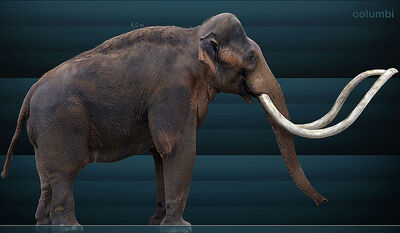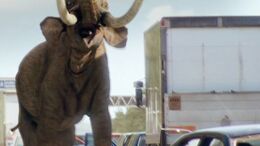| This article is under construction |
| This article is currently under construction by a user. To avoid edit conflicts, please do not edit until this template has been removed. |
The Columbian Mammoth (Mammuthus columbi) is an extinct species of elephantid mammoth of the Quaternary period that appeared in North America (in the present United States and to as far south as Nicaragua and Honduras) during the late Pleistocene. M. imperator is a synonym of the Columbian Mammoth. It's said to be a hybrid descendant of the Woolly Mammoth and a lineage related to the Steppe Mammoth.
The Columbian Mammoth was one of the last members of the American megafauna to go extinct, with the date of disappearance generally set at approximately 12,500 years ago. However, several specimens have been dated to 9,000 years ago or less and one near Nashville, Tennessee was reliably dated to only about 7,800 years ago.The Columbian mammoth was one of the largest of the mammoth species and also one of the largest elephants to have ever lived, measuring 4 meters (13 ft) tall and weighing up to 10 metric tons (11 short tons). It was 10.7 feet (3.3 m) long at the shoulder, and had a head that accounted for 12 to 25 percent of its body weight. It had impressive, spiral curved tusks which typically extended to 6.5 feet (2.0 m). A pair of Columbian Mammoth tusks discovered in central Texas was the largest ever found for any member of the elephant family: 16 feet (4.9 m) long.
It was a herbivore, with a diet consisting of varied plant life ranging from grasses to conifers. It is also theorized that the Columbian Mammoth ate the giant fruits of North America such as the Osage-orange, Kentucky coffee and Honey locust as there was no other large herbivore in North America then that could ingest these fruits. Using studies of African elephants, it has been estimated that a large male would have eaten approximately 700 pounds (320 kg) of plant material daily. The average Columbian mammoth ate 300 pounds of vegetation a day.
Taxonomy[]
The Columbian mammoth was first scientifically described in 1857 by naturalist Hugh Falconer, who named the species Elephas columbi after the explorer Christopher Columbus.
Fossils[]

The remains of Columbian Mammoths were discovered in the La Brea Tar Pits, located in Los Angeles, California, and the skeleton of one of them is on exhibit in that site's museum. The Waco Mammoth Site in Waco, TX holds the record for the largest known concentration of skeletons of mammoths believed to have died in the same event. This mammoth also lived in Mexico, where its remains are very common. A large individual is the central exhibit in the Regional Museum of Guadalajara, in the Mexican state of Jalisco.
In 1998, the Washington State Legislature approved the Columbian Mammoth as the State Fossil.
In The Media[]

Columbian Mammoth as it appears in Primeval.
- Land of the Mammoth.
- Wild New World aka Prehistoric America.
- National Geographic’s Prehistoric Predators.
- Prehistoric Denver & Prehistoric Dallas.
- The Columbian Mammoth makes many appearances in the TV series Primeval.
- La Brea Tar Pits Life sized replicas briefly seen in Land of the Lost.
- It was also seen in the PBS NOVA National Geographic Documentary special Ice Age Death Trap.
- Giant Screen Films Titans of the Ice Age.
- The Colombian Mammoth made an appearance in the edutainment special L.A. 10,000 B.C.
- Island of the Pygmy Mammoth.
- Nguangdaeng from Khan Kluay, appears more like a columbian mammoth rather than a normal elephant due to his abnormally large size, relatively small ears, and longer tusks and trunk.
Gallery[]
Columbian Mammoth/Gallery